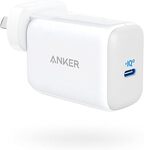Cheapest ever for this reputable Anker charger
Product Details:
- The Anker Advantage: Join the 55 million+ powered by our leading technology.
- High-Speed Charging: The 45W USB-C port charges iPhones up to 2.5x faster than with an original charger. Also supports Programmable Power Supply (PPS) for compatibility with Samsung Super Fast Charging.
- Universal Compatibility: Equipped with our exclusive PowerIQ 3.0 technology for flawless compatibility with a huge range of devices including MacBook, iPad, and the majority of flagship mobile devices.
- Plug Anywhere: The unique narrow design is ideal for use in tight spaces between other, larger plugs.
What You Get: PowerPort III 45W Pod USB-C Charger (cable not included), welcome guide, our worry-free 18-month warranty, and friendly customer service.



 CamelCamelCamel
CamelCamelCamel

It is per their product description